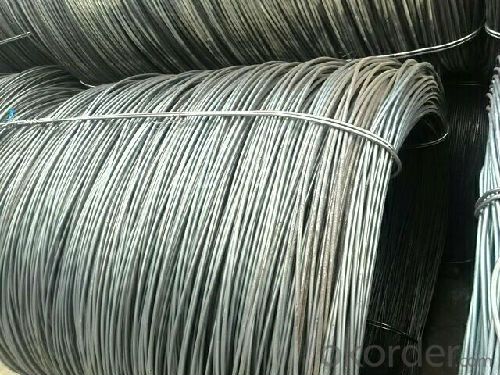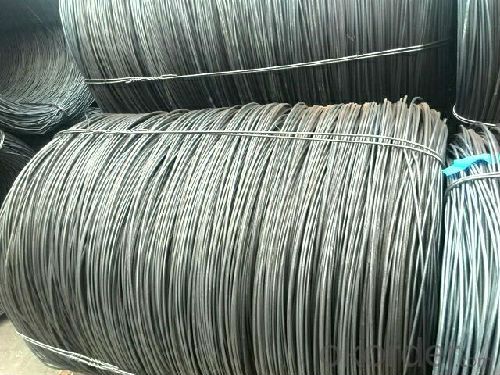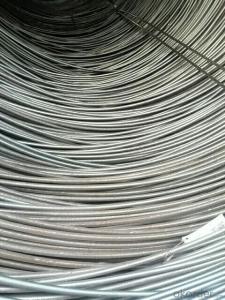Hot Rolled Wire Rod Sae1006-1018B
- Loading Port:
- China Main Port
- Payment Terms:
- TT or LC
- Min Order Qty:
- -
- Supply Capability:
- -
OKorder Service Pledge
OKorder Financial Service
You Might Also Like
Product Description:
OKorder is offering Hot Rolled Wire Rod SAE1006-1018B
at great prices with worldwide shipping. Our supplier is a world-class manufacturer of steel, with our products utilized the world over. OKorder annually supplies products to European, North American and Asian markets. We provide quotations within 24 hours of receiving an inquiry and guarantee competitive prices.
Hot Rolled Wire Rod SAE1006-1018B are ideal for structural applications and are widely used in the construction of buildings and bridges, and the manufacturing, petrochemical, and transportation industries.
Product Advantages:
OKorder's Hot Rolled Wire Rod SAE1006-1018B durable, strong, and resist corrosion.
Main Product Features:
· Premium quality
· Prompt delivery & seaworthy packing (30 days after receiving deposit)
· Corrosion resistance
· Can be recycled and reused
· Mill test certification
· Professional Service
· Competitive pricing
Product Specifications:
Steel Grade: Q195/235, SAE1006-1018B Standard: ASTM, GB
Diameter: 5.5mm, 6.5mm, 7mm,8mm,9mm,10mm,12mm,14mm
Type: in coil, coil weight around 2MT Alloy or Not: Alloy
Technique: Hot Rolled Place of Origin: China Mainland
Surface: round, no twisted, light and smooth Brand Name: HSKY
Chemical Composition: (Please kindly find our chemistry of our material based on Q195、Q235A and Q235B as below for your information)
Trademark | Rank | Chemical composition (quality score) % | |||||||
C | Si | Mn | S | P | |||||
| ≤ |
| ≤ | ≤ | |||||
Q195 |
| 0.06-0.12 | 0.30 | 0.25 | 0.050 | 0.045 | |||
Q235 | A | 0.14-0.22 | 0.30 | 0.30-0.65 | 0.050 | 0.045 | |||
Q235 | B | 0.12-0.20 | 0.30 | 0.30-0.70 | 0.045 | 0.045 | |||
Packaging & Delivery of Hot Rolled Wire Rod:
Packaging Detail: products are packed in coil, each coil weight around 2 MT, and then shipped by container or bulk vessel
FAQ:
Q1: Why buy Materials & Equipment from OKorder.com?
A1: All products offered byOKorder.com are carefully selected from China's most reliable manufacturing enterprises. Through its ISO certifications, OKorder.com adheres to the highest standards and a commitment to supply chain safety and customer satisfaction.
Q2: How do we guarantee the quality of our products?
A2: We have established an advanced quality management system which conducts strict quality tests at every step, from raw materials to the final product. At the same time, we provide extensive follow-up service assurances as required.
Q3: Can stainless steel rust?
A3: Stainless does not "rust" as you think of regular steel rusting with a red oxide on the surface that flakes off. If you see red rust it is probably due to some iron particles that have contaminated the surface of the stainless steel and it is these iron particles that are rusting. Look at the source of the rusting and see if you can remove it from the surface.
Images:


- Q:What are the common heat treatment processes for steel wire rod?
- The common heat treatment processes for steel wire rod include annealing, normalizing, quenching, and tempering.
- Q:How is steel wire rod used in the manufacturing of wire baskets and containers?
- Wire baskets and containers rely on steel wire rod as a vital material for their manufacturing. This material serves as the main building block for these products. The wire rod is typically made of high-quality steel and is available in different diameters to meet the specific requirements and strength needs of wire baskets and containers. To create wire baskets and containers, the steel wire rod undergoes various manufacturing processes. Initially, it is drawn through a series of dies to decrease its diameter and increase its length. This process, known as wire drawing, refines the wire rod and enhances its tensile strength. After wire drawing, the steel wire rod is straightened and cut into specific lengths, depending on the desired size of the wire baskets and containers. It is then bent, twisted, or welded into the desired shape and structure using specialized machinery and techniques. The high strength and durability of steel wire rod make it an ideal material for manufacturing wire baskets and containers. These products require robust construction to withstand heavy loads and resist bending or deformation. Steel wire rod provides the necessary strength and rigidity, ensuring that wire baskets and containers can safely hold and transport various items. Moreover, the properties of steel wire rod make it highly resistant to corrosion and wear, guaranteeing the longevity of wire baskets and containers, even in harsh environments. This is particularly important for applications such as storing or transporting goods in industries like agriculture, manufacturing, or logistics. Aside from its structural properties, steel wire rod also offers design versatility. It can be easily shaped and sized to meet specific customer requirements, enabling manufacturers to create wire baskets and containers of various shapes and sizes. Whether it's a simple open-top basket or a complex container with dividers and handles, steel wire rod can be customized to accommodate diverse needs. Overall, the utilization of steel wire rod in the manufacturing of wire baskets and containers is essential for ensuring their strength, durability, and functionality. Its exceptional properties provide the necessary support and resistance to meet the demands of different industries, making steel wire rod an integral component in their production.
- Q:How is steel wire rod used in the production of wire for musical instruments?
- The production of wire used for musical instruments requires steel wire rod, which serves as an essential component. Through a series of manufacturing processes, the steel wire rod is transformed into the desired wire form. To begin with, the steel wire rod serves as the starting point for creating wire of different gauges needed for various musical instruments. It is typically made from high-quality steel with specific chemical compositions and mechanical properties that ensure the desired strength and durability of the final wire product. Once obtained, the steel wire rod undergoes several processes such as drawing, annealing, and tempering to achieve the desired characteristics. Drawing involves pulling the wire rod through dies, reducing its diameter and increasing its length. This process refines the wire's surface finish and enhances its tensile strength. Annealing is another crucial step that includes heating the wire to a specific temperature and slowly cooling it. This process relieves internal stresses, improves the wire's ductility, and enhances its ability to resonate when used in musical instruments. Following annealing, the wire may undergo further processes like tempering. This involves heating the wire to a lower temperature and rapidly cooling it to achieve specific hardness and springiness. This step is crucial in creating wire with the desired flexibility and responsiveness required for different musical instruments. Once the wire is produced, it can be utilized in the construction of various musical instruments. For instance, steel wire is commonly used in guitar strings, piano wires, and brass instruments. Careful selection of the wire's gauge and composition ensures the desired pitch, tonal quality, and playability of the instrument. In conclusion, steel wire rod is a vital component in the production of wire for musical instruments. It undergoes various manufacturing processes to create wires of different gauges, strengths, and tonal characteristics. These wires are then used in the construction of diverse musical instruments, contributing to the creation of beautiful sounds and melodies.
- Q:What are the different types of steel wire rod surface defects that can occur during wire drawing?
- Some common types of steel wire rod surface defects that can occur during wire drawing include scratches, pits, scale, cracks, and decarburization.
- Q:What are the advantages of using steel wire rod in aerospace applications?
- Steel wire rod offers several advantages in aerospace applications. Firstly, it provides excellent strength and durability, making it ideal for withstanding the extreme conditions encountered during flight. This strength allows for the construction of lighter and more fuel-efficient aircraft. Additionally, steel wire rod has a high resistance to corrosion, which is crucial in aerospace applications where exposure to moisture and harsh environments is common. Furthermore, steel wire rod has exceptional flexibility, allowing it to be easily shaped and formed to meet the specific requirements of aircraft components. Lastly, steel wire rod is readily available and cost-effective, making it a practical choice for the aerospace industry. Overall, the use of steel wire rod in aerospace applications offers enhanced safety, performance, and cost-efficiency.
- Q:What are the different surface lubrication methods for steel wire rod?
- Some of the different surface lubrication methods for steel wire rod include dry drawing lubrication, oil-based lubrication, soap-based lubrication, and emulsion lubrication. These methods help to reduce friction and facilitate the wire drawing process, ensuring smooth and efficient production.
- Q:How is steel wire rod used in the production of nails?
- Steel wire rod is used in the production of nails as it serves as the primary raw material for manufacturing them. The wire rod is first drawn through a series of dies to reduce its diameter and achieve the desired thickness for the nails. It is then cut into appropriate lengths and shaped into the desired nail forms. The steel wire rod provides the necessary strength and durability required for nails, making it an essential component in their production process.
- Q:How is steel wire rod used in the manufacturing of suspension cables for bridges?
- Due to its strength and durability, steel wire rod is crucial for producing suspension cables used in the construction of bridges. These cables bear the weight of the bridge deck and transfer the load to the bridge towers or anchorages. To enhance their mechanical properties, steel wire rods undergo a series of heat treatments during the manufacturing process. This includes annealing, which softens the steel and increases its malleability, as well as quenching and tempering, which enhance its strength and toughness. These treatments enable the wire rods to withstand the high tension and stress experienced by suspension cables. Once the wire rods have been appropriately treated, they are further processed into wire strands by twisting multiple wire rods together. These wire strands are tightly wrapped around a central core, forming the main body of the suspension cables. The number and arrangement of the wire strands may vary depending on the bridge's design and load requirements. Using steel wire rod in suspension cables offers several advantages. Its high tensile strength enables the cables to resist the significant forces exerted on the bridge, including the weight of the deck, live loads, wind loads, and seismic forces. Additionally, the durability of steel wire rod ensures that the suspension cables can maintain their structural integrity for many decades. Furthermore, steel wire rod is highly resistant to corrosion, making it suitable for outdoor applications, even in harsh environments. This corrosion resistance is especially important for suspension cables, as they are continuously exposed to environmental factors like moisture, humidity, and temperature fluctuations. By utilizing steel wire rod, the risk of deterioration and failure due to corrosion is significantly reduced, ensuring the longevity and safety of the bridge. In conclusion, steel wire rod plays a vital role in the production of suspension cables for bridges. Its strength, durability, and corrosion resistance make it an ideal material for withstanding the high tension and stress experienced by the cables. By utilizing steel wire rod, suspension cables can provide the necessary support to bridges, ensuring their long-term structural integrity and safety.
- Q:How is the corrosion resistance of steel wire rod improved?
- The corrosion resistance of steel wire rod can be improved through various methods and techniques. One common approach is through the use of protective coatings. Steel wire rods can be coated with materials such as zinc, aluminum, or other corrosion-resistant metals to create a barrier between the steel and corrosive elements in the environment. These coatings act as sacrificial layers that corrode instead of the steel, thus prolonging the lifespan of the wire rods. Another method to enhance corrosion resistance is through the process of galvanization. This involves immersing the steel wire rod in a bath of molten zinc, which forms a protective layer on the surface of the rod. This galvanized coating acts as a physical barrier against corrosion, as well as providing cathodic protection to the steel, further reducing the risk of corrosion. Moreover, alloying steel with certain elements can also improve its corrosion resistance. For instance, stainless steel wire rods are commonly used in applications where corrosion resistance is crucial. Stainless steel contains a high percentage of chromium, which forms a passive and self-repairing oxide layer on the surface of the steel, protecting it from corrosion. In addition to these methods, the surface finish of the steel wire rod can also play a role in enhancing its corrosion resistance. Smoother and more polished surfaces tend to have better resistance to corrosion than rougher surfaces, as they offer fewer crevices or imperfections for corrosive agents to penetrate. Regular maintenance and proper storage of steel wire rods are also essential for maintaining their corrosion resistance. This includes keeping them in dry environments, protecting them from exposure to moisture or corrosive substances, and promptly addressing any signs of corrosion, such as rust, through cleaning and applying appropriate corrosion inhibitors. Overall, improving the corrosion resistance of steel wire rods involves a combination of coating techniques, alloying, surface finishing, and proper maintenance to ensure their longevity and performance in corrosive environments.
- Q:What are the factors that determine the price of steel wire rod?
- There are several factors that determine the price of steel wire rod. Some of the key factors include the cost of raw materials such as iron ore and other alloys, the demand and supply dynamics in the market, production and transportation costs, energy prices, currency exchange rates, and any taxes or tariffs imposed on steel imports or exports. Additionally, factors like global economic conditions, trade policies, and technological advancements in the steel industry can also influence the price of steel wire rod.
1. Manufacturer Overview |
|
|---|---|
| Location | |
| Year Established | |
| Annual Output Value | |
| Main Markets | |
| Company Certifications | |
2. Manufacturer Certificates |
|
|---|---|
| a) Certification Name | |
| Range | |
| Reference | |
| Validity Period | |
3. Manufacturer Capability |
|
|---|---|
| a)Trade Capacity | |
| Nearest Port | |
| Export Percentage | |
| No.of Employees in Trade Department | |
| Language Spoken: | |
| b)Factory Information | |
| Factory Size: | |
| No. of Production Lines | |
| Contract Manufacturing | |
| Product Price Range | |
Send your message to us
Hot Rolled Wire Rod Sae1006-1018B
- Loading Port:
- China Main Port
- Payment Terms:
- TT or LC
- Min Order Qty:
- -
- Supply Capability:
- -
OKorder Service Pledge
OKorder Financial Service
Similar products
New products
Hot products
Related keywords



























